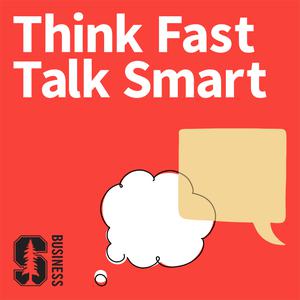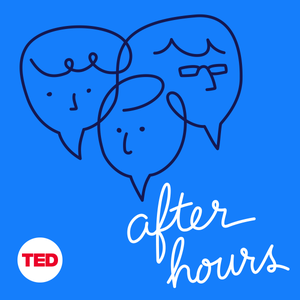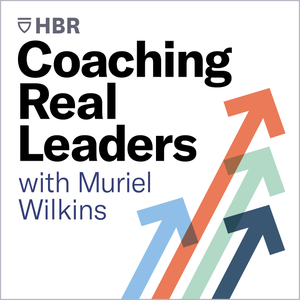
Think Fast, Talk Smart: Communication Techniques
Stanford GSB
Join Matt Abrahams, a lecturer of Strategic Communication at Stanford Graduate School of Business, as he sits down with experts in the field to discuss real-world challenges. How do I send my message clearly when put on the spot? How do I write emails to get my point across? How can I easily convey complex information? How do I manage my reputation? Whether you’re giving a toast or presenting in a meeting, communication is critical to success in business and in life.Think Fast, Talk Smart provides the tools, techniques, and best practices to help you communicate more effectively.
- 17 minutes 21 seconds139. Lose Yourself: The Secret to Finding Flow and Being Fully Present
Whether you're looking to boost your productivity, find more joy in your work, or simply be more present in the moment, you need flow — and research by Assistant Professor David Melnikoff could help you find it.
Melnikoff investigates how we pursue our goals, and how flow — the state of being totally immersed and engaged in what we’re doing — can help us achieve them. According to him, flow isn’t necessarily about enjoying a task or activity for its own sake, but more about the process of discovery that unfolds as we take action in the face of uncertainty. “The source of flow is engaging in an activity that allows you to reduce uncertainty about your future, engaging in actions that reduce possible future outcomes, or ideally, eliminate all possible future outcomes except for one,” he says. With each action that we take, the path before us narrows, leading us more directly to the goal that we’ve set.
In this episode of Think Fast, Talk Smart, Melnikoff shares why uncertainty presents us with the opportunity to step into the flow state, to experience more focus and engagement, and to supercharge our goal pursuit and performance
Episode Reference Links:
- David Melnikoff: Website
- Dr. Laurie Santos (Communicator Melnikoff admires)
- The Happiness Lab Podcast — Dr. Laurie Santos (Podcast of communicator Melnikoff admires)
- Ep.59 From Dreaming to Doing: How We Set and Achieve Goals Website / YouTube
- Ep.104 How to Change: Building Better Habits and Behaviors (And Getting Out of Your Own Way Website / YouTube
Connect:
- Email Questions & Feedback >>> [email protected]
- Episode Transcripts >>> Think Fast Talk Smart Website
- Newsletter Signup + English Language Learning >>> FasterSmarter.io
- Think Fast Talk Smart >>> LinkedIn Page, Instagram, YouTube
- Matt Abrahams >>> LinkedIn
- Stanford GSB >>> LinkedIn & Twitter
Chapters:
(00:00:00) Introduction
Host Matt Abraham welcomes guest David Melnikoff, an assistant professor of organizational behavior at Stanford GSB and an expert on flow and goal achievement.
(00:00:40) Understanding Flow and Its Benefits
The definition of flow and the reversal of the usual dynamic of goal pursuit.
(00:02:20) Achieving and Maintaining Flow
Misconceptions about achieving flow and the role of reducing uncertainty in engaging activities.
(00:06:22) Flow in Business and Leadership
Applying flow principles to business, emphasizing the structuring of tasks and goals to induce flow through uncertainty reduction.
(00:08:39) Personal Applications of Flow for Goal Pursuit
How to utilize flow principles to set and achieve goals with advice on framing tasks to maximize uncertainty and flow.
(00:11:03) Collaborative Flow and Communication
The potential for shared flow experiences in collaborative settings and the role of communication in facilitating flow.
(00:13:05) Goal Setting and Achievement Advice
Advice on goal setting, advocating for goals with a degree of uncertainty to enhance engagement and likelihood of entering a flow state.
(00:14:43) The Final Three Questions
David Melnikoff shares how he invites flow into his life, a communicator he admires, and his recipe for communication.
(00:16:17) Conclusion
See Privacy Policy at https://art19.com/privacy and California Privacy Notice at https://art19.com/privacy#do-not-sell-my-info.
23 April 2024, 1:00 pm - 22 minutes 41 seconds138. Speak Your Truth: Why Authenticity Leads to Better Communication
From the way you communicate, to the way build your life and career, Graham Weaver, MBA ’99, says it’s about “giving yourself permission to fully be yourself. You can never go wrong when you’re saying your truth.”
Weaver is a lecturer in management, a GSB alum, and the founder and a partner of Alpine Investors. He stresses the importance of direct communication, highlighting how avoiding it can lead to wasted time, energy, and even financial losses. Reflecting on his own experiences in private equity, Weaver admits to struggling with being conflict-averse and not speaking his truth directly, which resulted in getting into bad deals and big losses for his company. “People think that by being indirect, they’re being kind, but all they're doing is creating confusion,” he says. “Clarity is compassionate. Even if it's not what they want to hear, the more direct and clear you can be, the more compassionate that is for the other person.”
In this episode of Think Fast, Talk Smart, Weaver and host Matt Abrahams explore how being true to oneself not only fosters personal fulfillment but also enables us to show up better for others. Authenticity and self-belief lay the foundation for effective communication, leadership, and ultimately, success.
Episode Reference Links:
- Graham Weaver: Website
- Last Lecture Series: How to Live an Asymmetric Life (Link to Graham’s Last Lecture)
- H. Irving Grousbeck (Stanford profile of Graham’s mentor and communicator he most admires)
- Ep.82 - It’s Not About You: Why Effective Communicators Put Others First YouTube / Website
- Ep.118 - Maximizing Your Personal Brand: Communicating Who You Are to Help Get What You Want YouTube / Website
Connect:
- Email Questions & Feedback >>> [email protected]
- Episode Transcripts >>> Think Fast Talk Smart Website
- Newsletter Signup + English Language Learning >>> FasterSmarter.io
- Think Fast Talk Smart >>> LinkedIn Page, Instagram, YouTube
- Matt Abrahams >>> LinkedIn
- Stanford GSB >>> LinkedIn & Twitter
Chapters:
(00:00:00) Introduction
Matt Abrahams introduces guest Graham Weaver, a Stanford alum and lecturer in management at GSB.
(00:0:43) Interpersonal and Intrapersonal Skills in Business
How skills like understanding personal dreams and overcoming limiting beliefs play a critical role in business success.
(00:04:58) Living an Asymmetrical Life
Living an asymmetrical life, including the importance of doing hard things, pursuing your passions, committing long-term, and writing your own story.
(00:10:10) Lessons from Taylor Swift
Business and personal inspiration from Taylor Swift's response to professional setbacks, highlighting her work ethic and resilience.
(00:13:04) Personal Growth and Enlightenment
Graham’s journey towards enlightenment and the practices he adopts to improve his personal and professional life.
(00:16:08) The Final Three Questions
Graham shares what differentiates an exceptional from average leader, a communicator he admires and his ingredients for successful communication.
(00:21:05) Conclusion
See Privacy Policy at https://art19.com/privacy and California Privacy Notice at https://art19.com/privacy#do-not-sell-my-info.
16 April 2024, 1:00 pm - 22 minutes 12 seconds137. When Words Aren’t Enough: How to Excel at Nonverbal Communication
If communication is like painting, words are the primary colors. But to convey deeper meaning, we need a broader color palette, which Dana Carney says requires the mastery of nonverbal communication.
We often focus on the words that we say when honing our communication, but according to Carney, there are many instances “where nonverbals start to be more meaningful than verbals.” A professor at Berkeley’s Haas School of Business and the George Quist Chair in Business Ethics, Carney researches the nonverbal ways in which we communicate our biases, our preferences, our power, and our status.
As Carney explores in her forthcoming book, The Five Nonverbal Rules of Power, there are several key areas of nonverbal behavior that we need to grasp in order to fully tap our potential as communicators. In this episode of Think Fast, Talk Smart, she and host Matt Abrahams discuss how to read the nonverbal communication of others — and how to gain control of the nonverbals we express to the world.
Think Fast, Talk Smart is a podcast produced by Stanford Graduate School of Business. Each episode provides concrete, easy-to-implement tools and techniques to help you hone and enhance your communication skills.
Episode Reference Links:
- Dana Carney: Website
- Ep.12 - It’s Not What You Say, It’s How You Say It: How to Communicate Power Website / YouTube
- Ep.16 - How to Craft Your Body Language When Confronting Objections Website / YouTube
Connect:
- Email Questions & Feedback >>> [email protected]
- Episode Transcripts >>> Think Fast Talk Smart Website
- Newsletter Signup + English Language Learning >>> FasterSmarter.io
- Think Fast Talk Smart >>> LinkedIn Page, Instagram, YouTube
- Matt Abrahams >>> LinkedIn
- Stanford GSB >>> LinkedIn & Twitter
Chapters:
(00:00:00) Introduction
Matt Abrahams introduces guest Dana Carney, an expert in nonverbal communication.
(00:01:12) Understanding Nonverbal Communication
Foundational aspects of nonverbal communication, dividing it into perception and expression, and emphasizing the importance of facial expressions and body language.
(00:02:11) The Nonverbal Rules of Power
How nonverbal communication influences perceptions of power and status and the concept of the "five nonverbal rules of power".
(00:04:37) Cultural and Contextual Variations
The impact of culture and context on nonverbal cues, discussing how cultural differences can alter the interpretation of behaviors such as eye contact and proximity.
(00:08:10) The Balance Between Verbal and Nonverbal Communication
Verbal versus nonverbal communication and its significance especially in contexts where honesty or bias might be in question.
(00:09:15) Achieving Communication Goals Through Nonverbals
How understanding nonverbal cues can help individuals achieve specific social interaction goals.
(0012:51) Enhancing Nonverbal Communication Skills
Practical advice for becoming more aware of one's nonverbal communication, including self-observation and seeking feedback from others.
(00:16:13) The Final Three Questions
Dana shares a nonverbal behavior that demonstrates confidence, a communicator she admires, and her recipe for successful communication.
(00:21:09) Conclusion
See Privacy Policy at https://art19.com/privacy and California Privacy Notice at https://art19.com/privacy#do-not-sell-my-info.
9 April 2024, 1:00 pm - 23 minutes 49 seconds136. The Art of Disagreeing Without Conflict: Navigating the Nuance
Disagreement and conflict may look the same on the surface, but the two concepts are, in fact, very different. According to Julia Minson, knowing how these notions differ is crucial to how you approach them.
In this episode of Think Fast Talk Smart, Minson and strategic communication lecturer Matt Abrahams delve into the intricacies of conflict and disagreement. Minson, an associate professor of public policy at the Harvard Kennedy School and Stanford University alumna, also shares her expertise on decision-making and conflict negotiation. Minson emphasizes the need for genuine curiosity and receptiveness in communication to foster productive dialogue.
Think Fast, Talk Smart is a podcast produced by Stanford Graduate School of Business. Each episode provides concrete, easy-to-implement tools and techniques to help you hone and enhance your communication skills.
Episode Reference Links:
- Julia Minson: Website
- Underestimating Counterparts’ Learning Goals Impairs Conflictual Conversations (Julia’s study about people’s goals when talking to those they disagree with)
- To have better disagreements, change your words (Article by Julia about HEAR)
- Ep.30 - Dissolve Disagreements: How Communication Impacts Conflict: Website / YouTube
- Ep.72 - Quick Thinks: Talk it Out - How to Successfully Negotiate and Resolve Conflict: Website / YouTube
Connect:
- Email Questions & Feedback >>> [email protected]
- Episode Transcripts >>> Think Fast Talk Smart Website
- Newsletter Signup + English Language Learning >>> FasterSmarter.io
- Think Fast Talk Smart >>> LinkedIn Page, Instagram, YouTube
- Matt Abrahams >>> LinkedIn
- Stanford GSB >>> LinkedIn & Twitter
Chapters:
(00:00:00) Introduction
Matt introduces guest Julia Minson, who is an expert in decision-making, conflict negotiation, and the psychology of disagreement.
(00:00:54) Journey into Conflict and Disagreement Research
Julia gives insight into her background and what led her to research disagreement and conflict.
(00:01:55) Distinguishing Between Disagreement and Conflict
The difference between disagreement and conflict, and why understanding this distinction is crucial for effective communication.
(00:04:12) Strategies for Disagreeing Better
Practical advice on how to disagree constructively without escalating to conflict, focusing on expressing and acting with curiosity.
(00:07:05) Demonstrating Curiosity and Conversational Receptiveness
Tactics for showing curiosity and conversational receptiveness, including using the HEAR acronym to maintain constructive dialogues.
(00:14:38) Managing Conflict
Managing and navigating conflict, emphasizing emotional readiness and the importance of choosing battles wisely.
(00:18:25) The Final Three Questions
Julia shares personal experiences with conflict and disagreement, a communicator she admires, and her recipe for successful communication.
(00:22:48) Conclusion
swhyuSEcgmbk3s61xnk7vDzvceasb3fg7vcazb1
See Privacy Policy at https://art19.com/privacy and California Privacy Notice at https://art19.com/privacy#do-not-sell-my-info.
2 April 2024, 1:00 pm - 18 minutes 11 seconds135. Best of: The Personal and Professional Power of Emotional Awareness
Why deep connection with others starts by connecting more deeply with ourselves.
How are you feeling right now? According to Celine Teoh, we all need to ask ourselves that question more often — and be more precise in how we answer it.
Teoh is a facilitator of the course Interpersonal Dynamics, one of Stanford Graduate School of Business’s most iconic classes. In her work with students and as a CEO coach, Teoh encourages people to get better acquainted with their feelings. “Feelings are data,” she says. “In the rest of our logical lives, we would never make decisions on bad or highly abstract data. But we’ll do that with feelings.”
In this episode of Think Fast, Talk Smart: The Podcast, Teoh and host Matt Abrahams discuss how developing greater emotional awareness can help us achieve more agency and empathy in our personal and professional lives.
Think Fast, Talk Smart is a podcast produced by Stanford Graduate School of Business. Each episode provides concrete, easy-to-implement tools and techniques to help you hone and enhance your communication skills.
Episode Reference Links:
- Celine Teoh: Website
- Interpersonal Dynamics (Program at GSB Celine facilitates)
- Connect - Building Exceptional Relationships (Book by Carol Robin that Celine recommends)
- The Gottman Institute (Website for John Gottman, whose research Celine mentions and is referenced in the Interpersonal Dynamics course)
- Ep.77 - All the Feels: The Personal and Professional Power of Emotional Awareness: YouTube / Website
Connect:
- Email Questions & Feedback >>> [email protected]
- Episode Transcripts >>> Think Fast Talk Smart Website
- Newsletter Signup + English Language Learning >>> FasterSmarter.io
- Think Fast Talk Smart >>> LinkedIn Page, Instagram, YouTube
- Matt Abrahams >>> LinkedIn
- Stanford GSB >>> LinkedIn & Twitter
Chapters:
(00:00:00) Introduction
Host Matt Abrahams introduces guest Celine Teoh and the episodes' focus on the value of emotions in communication.
(00:01:09) Discovering Self Through Interpersonal Dynamics
Overview of the Interpersonal Dynamics course at Stanford GSB, also known as "touchy feely"
(00:03:48) Integrating “Touchy Feely” in Logical and Action-Oriented Environments
Incorporating empathy and emotional connection in organizations that prioritize logic and action.
(00:05:47) Enhancing Connection and Empathy
Advice on building connections with others, including the importance of being clear and embracing vulnerability.
(00:08:36) Managing Conflict with Empathy
Approaching challenges and conflict at work in a way that maintains and strengthens relationships.
(00:11:29) Enhancing Empathy, Feedback, and Communication Skills
Guidance for improving empathy, seeking feedback, and honing communication skills.
(00:13:52) The Final Three Questions
Celine Teoh shares the best communication advice she has received, a communicator she admires, and outlines her first three ingredients for successful communication.
(00:17:07) Conclusion
See Privacy Policy at https://art19.com/privacy and California Privacy Notice at https://art19.com/privacy#do-not-sell-my-info.
26 March 2024, 2:00 pm - 24 minutes 39 seconds134. How to Chat with Bots: The Secrets to Getting the Information You Need from AI
Leveraging AI to unlock new levels of creativity and communication innovation
Join Matt Abrahams with creativity and innovation experts Jeremy Utley and Kian Gohar to explore the transformative potential of AI in the realms of creativity and problem-solving.
If you treat artificial intelligence like an oracle, you’ll likely be disappointed. But if you treat it like a teammate, Utley and Gohar say you’ll be surprised just how helpful a collaborator it can be.
Utley, an adjunct professor at the Stanford d.school, and Gohar, a bestselling author, keynote speaker, and futurist, have researched how teams can integrate AI into existing workflows to generate more creative ideas and streamline problem-solving. As they’ve found, large language models (LLMs) like ChatGPT can be powerful tools for innovation. But without knowing how to implement them, “Most teams leave the vast majority of their innovation potential on the table,” Utley says. In a new white paper, he and Gohar illuminate the path teams can take to use generative AI as a “conversation partner” and transform their brainstorming efforts as a result.
In this episode of Think Fast, Talk Smart, Utley and Gohar discuss how innovators can stop viewing AI as a magic 8-ball, and start treating it as a companion — one ready to roll up its sleeves and dig deep for new ideas.
Think Fast, Talk Smart is a podcast produced by Stanford Graduate School of Business. Each episode provides concrete, easy-to-implement tools and techniques to help you hone and enhance your communication skills.
Episode Reference Links:
- Jeremy Utley: Website
- Jeremy's book: Ideaflow
- Kian Gohar: Website + Geolab
- Kian's book: Competing In The New World Of Work
- FIXIT
- HBR article by Jeremy and Kian: Don’t Let Gen AI Limit Your Team’s Creativity
- Ep.70 - Keep ’Em Coming: Why Your First Ideas Aren’t Always the Best: YouTube / Website
- Ep.77 - Quick Thinks: AI Has Entered the Chat: YouTube / Website
- Communicators Kian admires:
- Peggy Noonan + Declarations at The Wall Street Journal
- Sam Horn + Tongue Fu!: How to Deflect, Disarm, and Defuse Any Verbal Conflict
Connect:
- Email Questions & Feedback >>> [email protected]
- Episode Transcripts >>> Think Fast Talk Smart Website
- Newsletter Signup + English Language Learning >>> FasterSmarter.io
- Think Fast Talk Smart >>> LinkedIn Page, Instagram, YouTube
- Matt Abrahams >>> LinkedIn
- Stanford GSB >>> LinkedIn & Twitter
Chapters:
(00:00:00) Introduction to Utley & Gohar
Matt Abrahams introduces guests Jeremy Utley and Kian Gohar, and their respective books.
(00:01:02) Motivation Behind the Study on AI's Impact
AI's impact on creativity and problem-solving, including an experiment involving human ideation with and without AI assistance.
(00:03:32) Research Findings on AI and Innovation
Specific practices to effectively use AI in teams for idea generation and the counterintuitive feelings associated with AI-assisted work.
(00:04:37) The Counterintuitive Nature of AI Assistance
Why teams that used AI effectively felt worse about their work, and the importance of adjusting work processes to incorporate AI as a collaborative tool.
(00:07:59) The FIXIT Methodology for AI Collaboration
The FIXIT methodology, a five-step process to enhance collaboration with AI.
(00:12:29) Enhancing Conversations with AI
Improving conversations with AI, including using audio messages for interaction and exploring different large language models for varied inputs.
(00:17:45) The Final Three Questions
Jeremy Utley offers a starting point for individuals new to ChatGPT, and Kian Gohar shares two communicators he admires and his three ingredients for successful communication.
(00:22:57) Conclusion
See Privacy Policy at https://art19.com/privacy and California Privacy Notice at https://art19.com/privacy#do-not-sell-my-info.
19 March 2024, 2:36 pm - 37 minutes 1 second133. From Good to Super: How Supercommunicators Unlock the Language of Connection
The ways supercommunicators operate and how to emulate their techniques.
Across more than 130 episodes, Think Fast, Talk Smart has touched a lot on what it takes to be a good communicator. But what about reaching that next level? What about being a “supercommunicator”? Supercommunicator is a term used by Pulitzer Prize winning journalist and author Charles Duhigg in his latest book, Supercommunicators: How to Unlock the Secret Language of Connection.
In this podcast episode, Abrahams and Duhigg explore the precise techniques that distinguish a good communicator from a “supercommunicator:” traits such as active listening; looping for understanding to demonstrate genuine engagement; and identifying what someone is truly feeling, underneath what they actually say.
Episode Reference Links:
- Charles Duhigg: Website
- Charles Duhigg: Books
- Duhigg’s New Yorker article
- Thalia Wheatley’s research study: The Repurposed Social Brain
- Nicholas Epley’s research paper: Overly Shallow?: Miscalibrated Expectations Create a Barrier to Deeper Conversation
- Alison Wood Brooks’ research paper: The Conversational Circumplex: Identifying, Prioritizing, and Pursuing Informational and Relational Motives in Conversation
- Michael Yeomans’ research paper: It Helps to Ask: The Cumulative Benefits of Asking Follow-Up Questions
- Sheila Heen’s research project: Harvard Negotiation Project
- Ep.92 - No Regrets: How to Take Risks: YouTube / Website
- Ep.82 - It’s Not About You: Why Effective Communicators Put Others First: YouTube / Website
- Ep.103 - Simple is a Superpower: How to Communicate Any Idea to an Audience: YouTube / Website
Connect:
- Email Questions & Feedback >>> [email protected]
- Episode Transcripts >>> Think Fast Talk Smart Website
- Newsletter Signup + English Language Learning >>> FasterSmarter.io
- Think Fast Talk Smart >>> LinkedIn Page, Instagram, YouTube
- Matt Abrahams >>> LinkedIn
- Stanford GSB >>> LinkedIn & Twitter
Chapters:
(00:00:00) Introduction
Host Matt Abrahams introduces guest Charles Duhigg and his new book Super Communicators.
(00:01:26) Transition from Habits to Communication
Duhigg shares how personal experiences and a desire to understand human interactions motivated him to explore communication.
(00:02:51) The Neuroscience of Connection
The neuroscience behind successful communication and the role of neural entrainment in establishing connection and understanding.
(00:04:21) Storytelling as a Powerful Communication Tool
The importance of storytelling in communication and how stories foster empathy and engagement.
(00:06:16) Identifying and Aligning Conversation Types
Three types of conversations (practical, emotional, social) and the necessity of aligning conversation types for effective communication.
(00:08:07) Practices of Super Communicators
Insights into the habits of super communicators, including their approach to recognizing conversation types and the importance of deep listening.
(00:15:02) Navigating Conflict Through Effective Communication
Managing conflictual conversations with a focus on listening, understanding, and managing control dynamics.
(00:20:50) Challenges of Online Communication
Challenges and strategies for communicating in online and virtual settings.
(00:25:04) The Craft and Impact of Storytelling
Approaches to storytelling and its significance in making complex ideas memorable and engaging.
(00:29:06) Developing New Communication Habits
New communication habits developed from Duhigg's research and their impact on personal and professional interactions.
(00:31:02) The Final Three Questions
Charles Duhigg discusses the importance of deep questions, the communicator he most admires, and his recipe for successful communication.
See Privacy Policy at https://art19.com/privacy and California Privacy Notice at https://art19.com/privacy#do-not-sell-my-info.
12 March 2024, 2:00 pm - 24 minutes 29 seconds132. Lean Into Failure: How to Make Mistakes That Work
Effective and productive teams and relationships are based on the ability to communicate safely and to fail successfully. In this episode, Amy Edmondson, a professor at Harvard Business School and author of The Right Kind of Wrong: The Science of Failing Well, shares profound insights on the different types of failure—basic, complex, and intelligent—and their implications for learning and innovation.
In her conversation with host and Strategic Communications lecturer Matt Abrahams, Edmonson opens up about her struggles with failure, highlighting the importance of moving from rumination to reflection. This episode offers listeners a comprehensive guide to fostering an environment where failure is not feared but embraced as a crucial step toward growth and success.
Episode Reference Links:
- Amy Edmondson: Website
- Amy’s Books: The Fearless Organization & Right Kind of Wrong
- Amy’s paper with Ingrid Nembhard: Making it Safe: The Effects of Leader Inclusiveness
- Amy’s admired communicator Nicolai Tangen’s podcast: In Good Company
- Ep.26 - Words Matter: How to Make Your Communication Inclusive: Website / YouTube
- Ep.112 - From Mistakes to “Missed Takes” : Youtube
Connect:
- Email Questions & Feedback >>> [email protected]
- Episode Transcripts >>> Think Fast Talk Smart Website
- Newsletter Signup + English Language Learning >>> FasterSmarter.io
- Think Fast Talk Smart >>> LinkedIn Page, Instagram, YouTube
- Matt Abrahams >>> LinkedIn
- Stanford GSB >>> LinkedIn & Twitter
Chapters:
(00:00:00) Introduction
Matt Abrahams introduces guest Amy Edmondson and her new book the Right Kind of Wrong: The Science of Failing Well.
(00:01:38) Psychological Safety Communication Strategies
The concept of psychological safety and its role in fostering open communication and risk-taking within teams.
(00:05:36) Leader's Role in Creating a Safe Environment
A leader's role in acknowledging vulnerability and creating a culture of appreciation for candid feedback.
(00:08:27) Empowering Every Team Member
Benefits of empowering every team member to contribute to psychological safety.
(00:10:46) Understanding Failure
The importance of psychological safety in admitting mistakes and exploring the concept of failure.
(00:14:07) Communicating About Failure
How leaders can effectively communicate about failures to encourage team learning and resilience.
(00:18:34) Unequal Opportunity to Fail
The unequal opportunity to fail, particularly for underrepresented groups.
(00:20:39) The Final Three Questions
Amy Edmondson shares her challenges with failure, a communicator she most admires, and three ingredients to a successful communication recipe.
See Privacy Policy at https://art19.com/privacy and California Privacy Notice at https://art19.com/privacy#do-not-sell-my-info.
5 March 2024, 3:00 pm - 22 minutes 57 seconds131. Friction Fixing: How to Use Obstacles to Your Advantage
Why resistance isn’t always a bad thing.
Friction — that’s Professor Huggy Rao’s metaphor for the forces that hamper workplace efficiency. But as he says, some friction can be helpful — if you know how to use it.
In his book, The Friction Project: How Smart Leaders Make the Right Things Easier and the Wrong Things Harder, Rao and coauthor Robert I. Sutton explore how operational obstacles show up in the workplace and, more importantly, what we can do about them. Through what Rao calls “friction fixing,” leaders can “take out the bad friction to make the right things easy to do [and] put in good friction to make the wrong things harder [to do].”
As Rao discusses with host Matt Abrahams on this episode of Think Fast, Talk Smart, leaders can eliminate bad friction through good communication. “Communication matters a lot,” he says. “The simple rule is, make sure a 10-year-old can understand it on the first try.”
Episode Reference Links:
- Huggy Rao: Website
- Huggy’s Books: The Friction Project, Scaling Up Excellence, & Market Rebels
- Huggy’s Successful Communication Recipe - “Ah! Aha! Haha!” by Ramji Raghavan
- Ep.14: Be Better at Work: How to Communicate Better with Coworkers and Employees: Website / YouTube
Connect:
- Email Questions & Feedback >>> [email protected]
- Episode Transcripts >>> Think Fast Talk Smart Website
- Newsletter Signup + English Language Learning >>> FasterSmarter.io
- Think Fast Talk Smart >>> LinkedIn Page, Instagram, YouTube
- Matt Abrahams >>> LinkedIn
- Stanford GSB >>> LinkedIn & Twitter
Chapters:
(00:00:00) Introduction
Host Matt Abrahams introduces guest, Huggy Rao, and his latest book on the importance of focusing on friction to become our best selves.
(00:01:24) Scaling Mindsets and Communication
Insights on scaling excellence and the critical role of simple communication in fostering the right mindset.
(00:04:28) AstraZeneca: Scaling Simplification
A case study on simplification efforts at AstraZeneca & the gift of time that they gave their employees.
(00:08:49) Understanding Friction: Terrible and Wonderful
The dual nature of friction, highlighting its role as both a hindrance and a catalyst for decision-making.
(00:11:05) Jargon Monoxide
Complicated jargon’s impact on organizations, and the need for simplicity in communication.
(00:13:03) The Art of Storytelling
The benefits & goals of storytelling, creating moral elevation & emotional connection.
(00:15:12) Job Titles and Accountability
An experiment on the impact of personalized job titles on team performance and accountability in tech startups and the introduction of “good friction”.
(00:17:57) The Final Three Questions
Huggy shares his strategy for reducing friction in his life, a story about the communicator he most admires, Saul Alinsky, and his three ingredients for a successful communication recipe, Aah! Aha! Ha-Ha!
See Privacy Policy at https://art19.com/privacy and California Privacy Notice at https://art19.com/privacy#do-not-sell-my-info.
27 February 2024, 3:00 pm - 20 minutes 3 seconds130. Best Of: How to Maintain a Powerful Presence in Your Communication
“Simple language, forceful language, vivid language, and keeping it simple and direct,” says Professor Jeffrey Pfeffer, are all powerful tools to strengthen your communication.
Host and Stanford Graduate School of Business lecturer Matt Abrahams interviews Pfeffer, the author many books, including Power: Why Some People Have It and Others Don't, about the verbal and nonverbal ways we can harness, or give away, our authority when we’re speaking to others. Pfeffer is also the host of the podcast Pfeffer on Power and teaches the Stanford GSB online course Discover the Paths to Power.
Think Fast, Talk Smart is a podcast produced by Stanford Graduate School of Business. Each episode provides concrete, easy-to-implement tools and techniques to help you hone and enhance your communication skills.
Episode Reference Links:
- Jeffrey Pfeffer's podcast: Pfeffer on Power
- Jeffrey Pfeffer's books: Dying for a Paycheck & Power: Why Some People Have It and Others Don't
- Stanford GSB Online Course: Discover the Paths to Power
- Ep 12, Deb Grunfeld: YouTube / Website
- Ep 44, Melissa Jones Briggs: YouTube / Website
Connect:
- Email Questions & Feedback >>> [email protected]
- Episode Transcripts >>> Think Fast Talk Smart Website
- Newsletter Signup + English Language Learning >>> FasterSmarter.io
- Think Fast Talk Smart >>> LinkedIn Page, Instagram, YouTube
- Matt Abrahams >>> LinkedIn
- Stanford GSB >>> LinkedIn & Twitter
Chapters:
(00:00:00) Introduction
Matt Abrahams introduces the episode, highlighting the importance of power and presence in communication.
(00:01:31) Defining Power and Status
Jeffrey Pfeffer shares his definition of power and status, emphasizing their significance in achieving goals despite opposition.
(00:02:45) Nonverbal & Verbal Behaviors to Communicate Power
Specific behaviors that convey power, and those to avoid.
(00:05:46) Emotion and Power
Pfeffer explores the role of emotion in conveying power, highlighting the effectiveness of displaying strong emotions like anger and passion.
(00:09:11) Virtual Communication
Strategies for projecting competence and higher status in virtual communication are discussed, emphasizing the importance of appearance and framing on video calls.
(00:10:55) Communicating Across Power Levels
Jeffrey Pfeffer advises on crafting concise, powerful messages for communication with higher-status individuals, emphasizing the importance of directness and presentation in person.
(00:12:06) Tailoring Messages with Flattery
Pfeffer suggests beginning communications with flattery, highlighting its effectiveness in making the recipient more receptive to your message.
(00:13:33) The Importance of ‘Warming Up’
Why we should warm up physically and vocally before important communications.
(00:16:33) The Final Three Questions
Pfeffer shares his best communication advice in a concise slide title, the communicators he “admires”, and his three ingredients for a successful communication recipe.
(00:19:20) Conclusion and Appreciation
See Privacy Policy at https://art19.com/privacy and California Privacy Notice at https://art19.com/privacy#do-not-sell-my-info.
20 February 2024, 3:00 pm - 23 minutes 1 second129. Connect Deeply: How to Communicate So People Feel Seen and Heard
New York Times Opinion columnist David Brooks shares how to communicate so that others feel seen, heard, and understood.
All too often, we communicate without really connecting. The key to building deep connections with others, says David Brooks, is to make them feel seen and heard.
Brooks is a writer for the New York Times, the Atlantic, and the best-selling author of several books. In his latest, How to Know a Person: The Art of Seeing Others Deeply and Being Deeply Seen, he explores how vulnerability — both being vulnerable ourselves and creating space for others to be as well — is the key to fostering deeper connections at home, at work, and throughout our lives. “[People] need to be seen, heard, and understood,” he says. “If you hide yourself from the emotional intimacies of life, you're hiding yourself from life itself.”
In this episode of Think Fast, Talk Smart, Brooks and host Matt Abrahams discuss the fundamentals of communicating with vulnerability and empathy, outlining the skills that anyone can learn and use to connect more deeply in their relationships.
Episode Reference Links:
- Full list of David Brooks books
- Bryan Stevenson
- George Orwell
- C.S. Lewis
- Oprah Winfrey Video
- Ep 64, Carissa Carter: YouTube / Website
- Ep 101, Geoffrey Cohen: YouTube / Website
Connect:
- Email Questions & Feedback >>> [email protected]
- Episode Transcripts >>> Think Fast Talk Smart Website
- Newsletter Signup + English Language Learning >>> FasterSmarter.io
- Think Fast Talk Smart >>> LinkedIn Page, Instagram, YouTube
- Matt Abrahams >>> LinkedIn
- Stanford GSB >>> LinkedIn & Twitter
Chapters:
(00:00:00) Introduction
(00:01:26) Personal Motivation
David Brooks shares insights into his journey and the motivation behind his latest book.
(00:04:01) Barriers to Connection
Common barriers to connection including egotism, anxiety, worldview, and lack of questioning.
(00:04:43) The Stages of Empathy
David Brooks breaks down empathy into components such as mirroring, mentalizing, and caring, and recognizing your own emotion
(00:07:40) Keys to Meaningful Conversation
Attention as an on-off switch, loud listening, avoiding topping responses, embracing pauses, and making people authors
(00:11:22) Understanding Illuminators and Diminishers
Illuminators are those who make you feel seen and valued through curiosity and active listening and suggestions and suggestions on how to be a better illuminator and conversationalist.
(00:14:01) How to Be a Better Public Speaker
The importance of vulnerability, humor, and storytelling.
(00:16:25) Paradigmatic vs. Narrative Modes of Thinking
Jerome Bruner's concept of paradigmatic for writing and convincing, Narrative mode for understanding a fellow human being.
(00:18:02) David Brooks' Journey
Becoming a journalist, inspired by childhood reading and early experiences as a police reporter & admiration for Oprah Winfrey as an admirable listener.
(00:19:52) Ingredients for Successful Communication
David Brooks outlines his three essential ingredients for effective communication: depth of passion, vulnerability, and clarity.
(00:22:27) Closing
See Privacy Policy at https://art19.com/privacy and California Privacy Notice at https://art19.com/privacy#do-not-sell-my-info.
13 February 2024, 3:00 pm - More Episodes? Get the App
Your feedback is valuable to us. Should you encounter any bugs, glitches, lack of functionality or other problems, please email us on [email protected] or join Moon.FM Telegram Group where you can talk directly to the dev team who are happy to answer any queries.
 Women at Work
Women at Work
 After Hours
After Hours
 HBR IdeaCast
HBR IdeaCast
 Coaching Real Leaders
Coaching Real Leaders
 HBR On Leadership
HBR On Leadership
 TED Business
TED Business